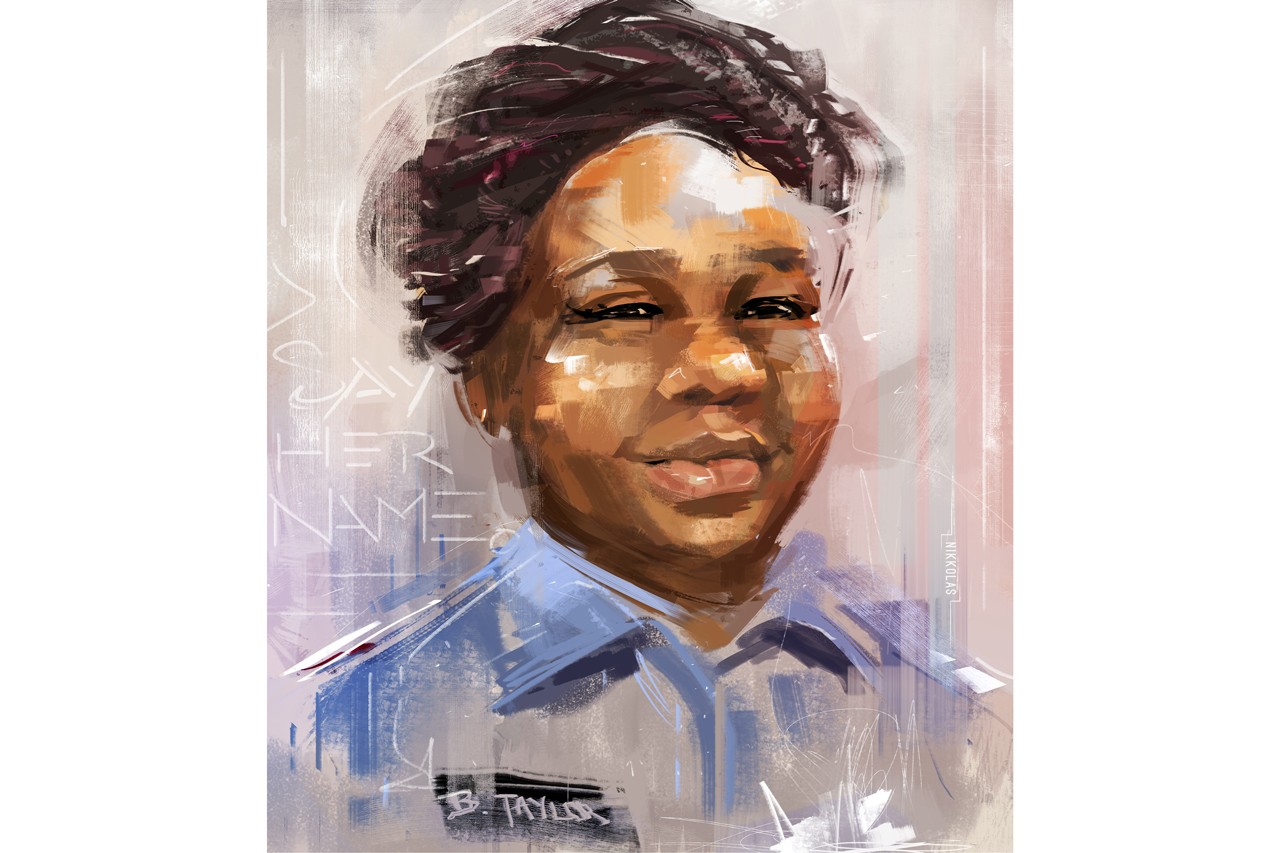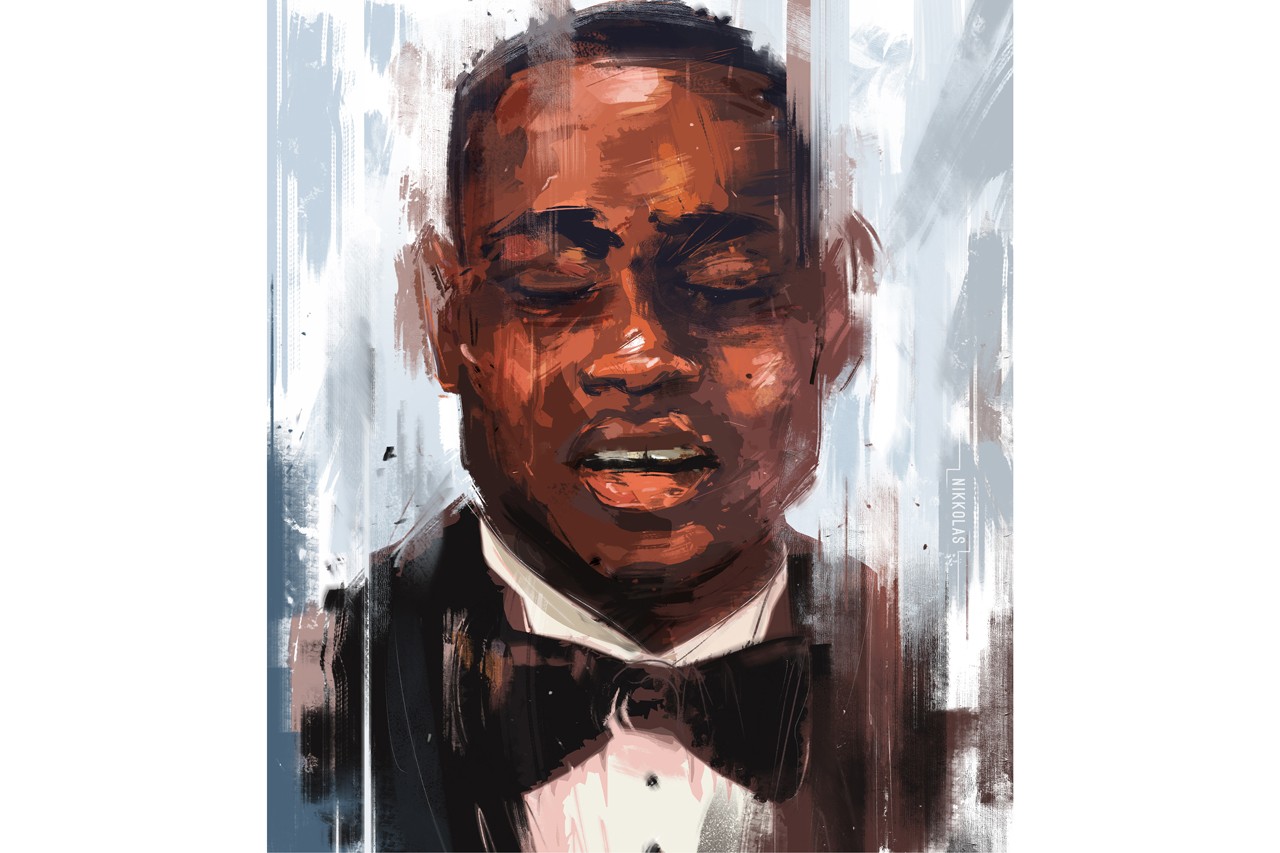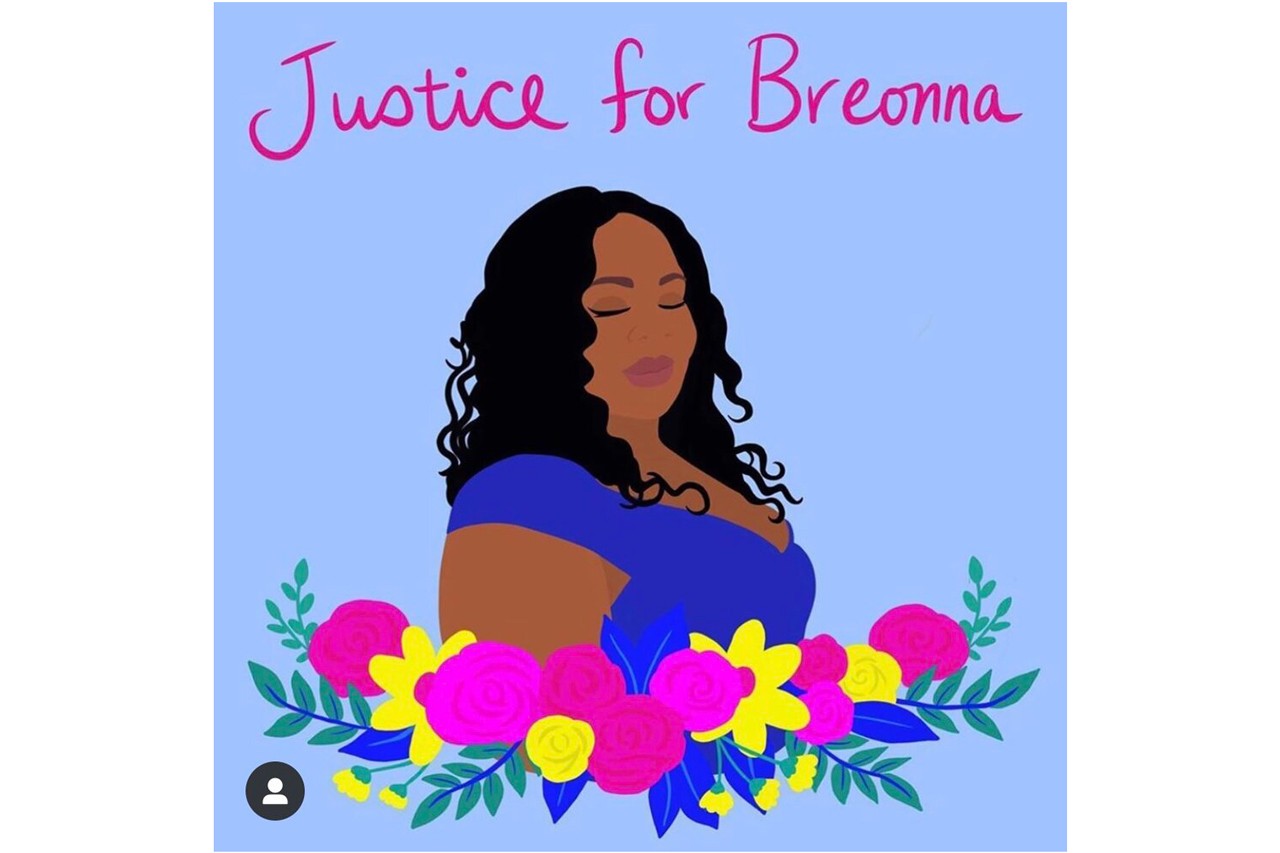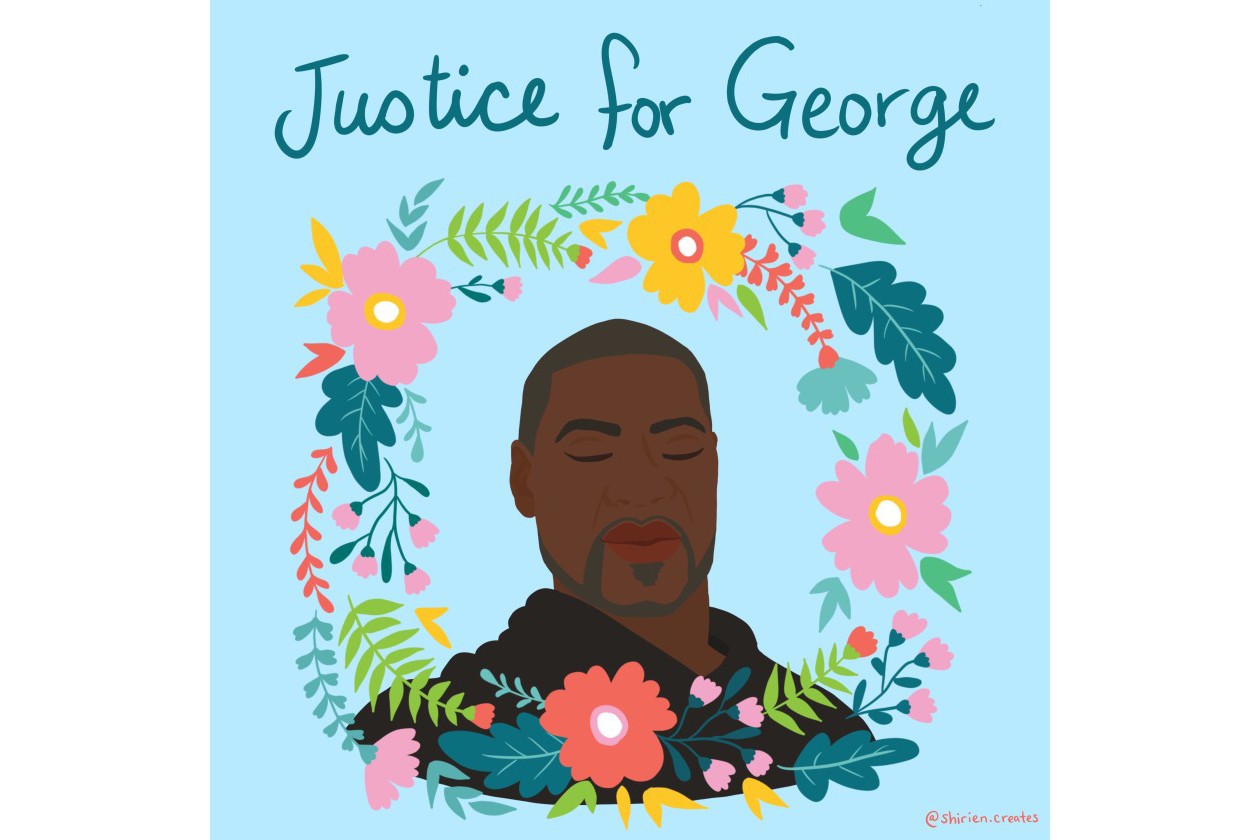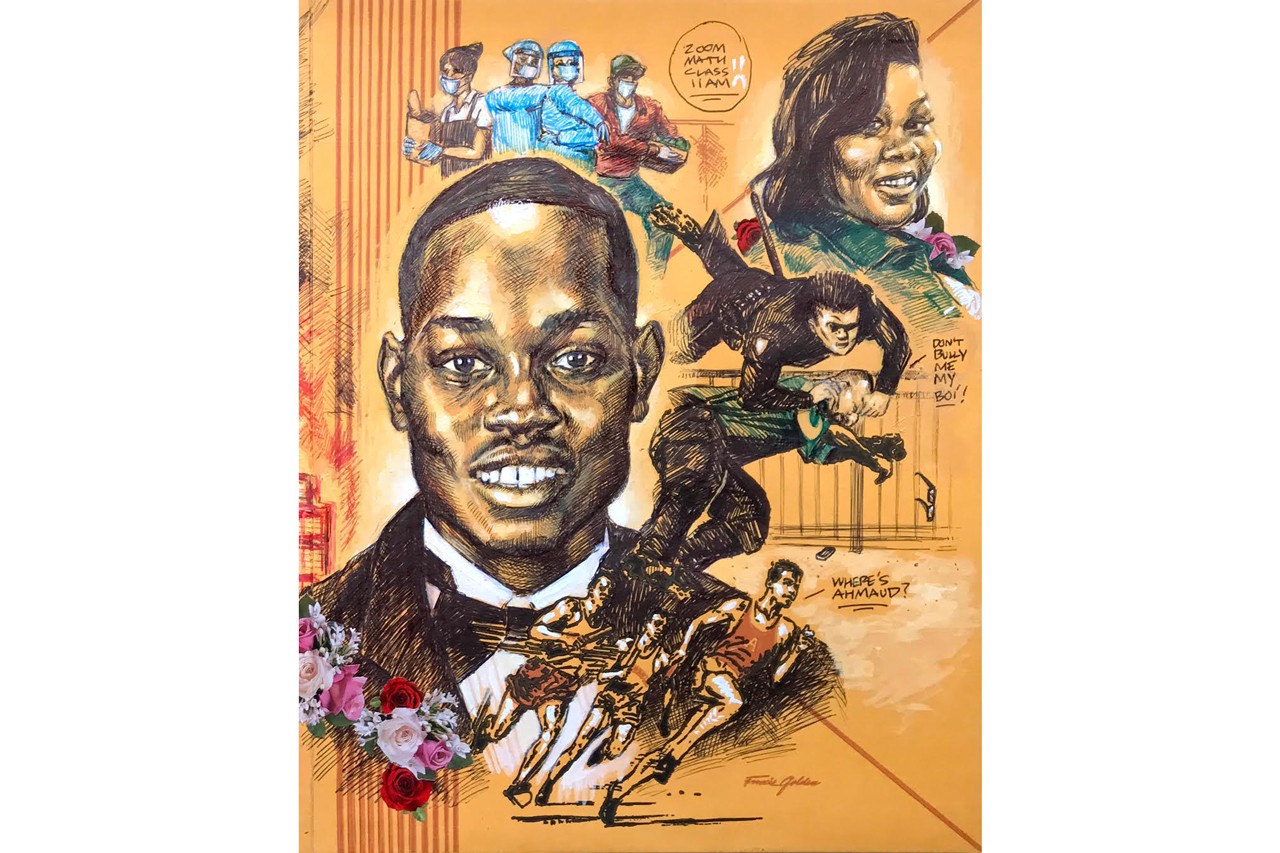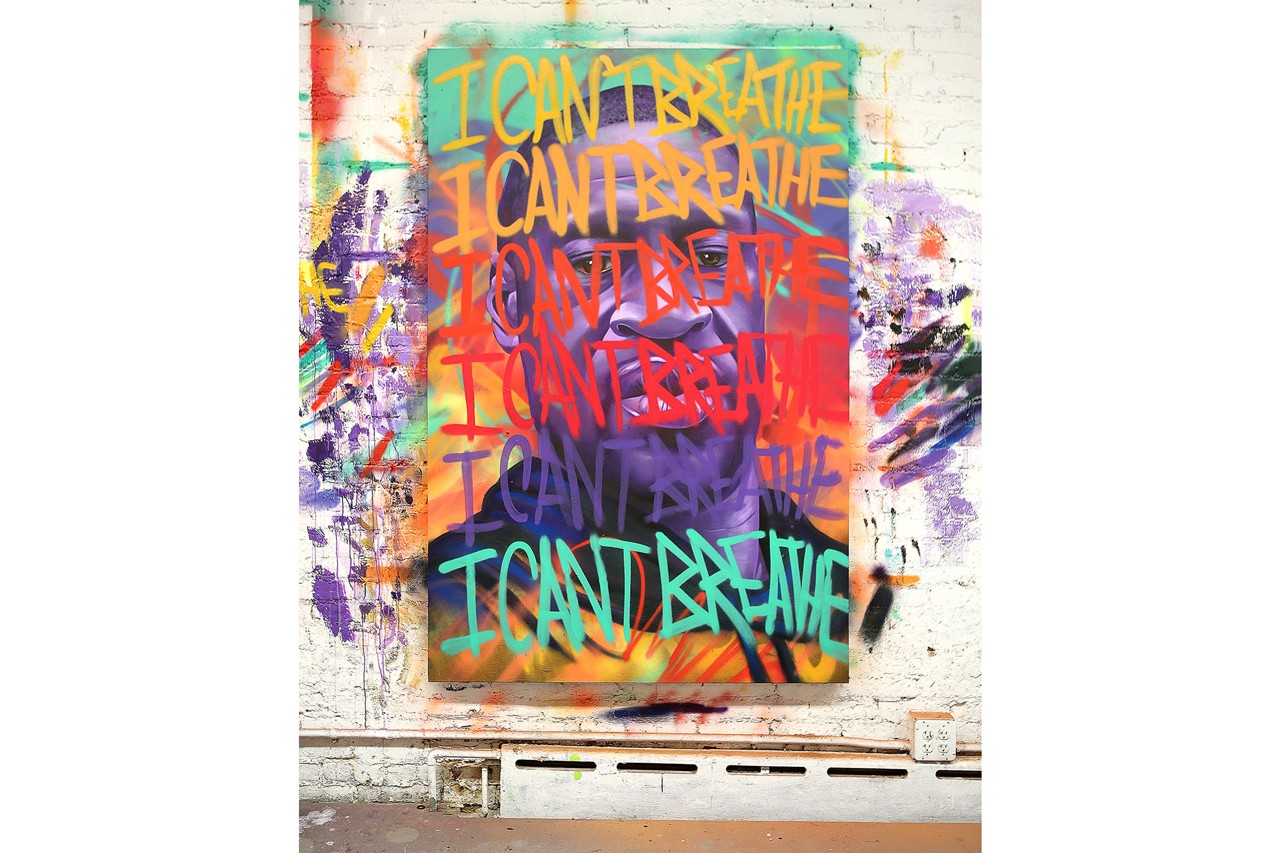#BlackLivesMatter protests are raging across the United States following the deaths of Ahmaud Arbery, Breonna Taylor, George Floyd, and the many others killed as a result of anti-Black racism and police brutality. In the most recent, high-profile case, then-Minneapolis police officer Derek Chauvin knelt on Floyd’s neck for eight minutes as Floyd gasped I can’t breathe.
Following Floyd’s death on May 25, all four officers involved in the incident were fired. Chauvin was recently charged with second-degree murder while the other officers were charged with aiding and abetting murder. Floyd’s family members and protestors across the U.S., however, are demanding that Chauvin be charged with first-degree murder. While charges for the authorities who killed Floyd have been elevated, the Louisville officers who killed Taylor are still employed, but on administrative leave.
In the days since Floyd was killed in police custody, artists have taken to social media to share original artworks, created in both physical and digital mediums, to honor his memory, Arbery’s, Taylor’s as well as those of Black victims of police violence and racism. Los Angeles-based artist and activist Nikkolas Smith shared his tribute art for Floyd, Taylor, and Arbery — which have all been shared by Michelle Obama, recently. Moreover, Palestinian-American artist Shirien Damra posted colorful illustrations of Floyd and Taylor with their portraits circled by a wreath of vivid flowers.
Take a look at the works with statements from the artists below and read HYPEBEAST’s How to Stay Informed, Vocal and Safe article for a statement from the company on the recent events and for resources, charities and petitions for the ongoing protests.
What do you want to achieve with this work?
I want my Artivism to be a voice for those voiceless and valuable lives that have been unjustly taken from this earth. Black lives especially, which are being disproportionately murdered due to baseless fears and systemic racism. I want my art to inspire everyone to take a stand and actively work to tear down this centuries-old pandemic.
What response have you received?
The viral response has been overwhelming in the best way. Michelle Obama recently shared my tribute art for George Floyd, Breonna Taylor and Ahmaud Arbery, and I was in shock. People all over the world are sharing the pieces now, and commenting to say that they stand in solidarity with us in this fight for Black lives.
How do you see the art world/industry responding to the protests?
I’ve seen so many artists responding to the protests with protest art in their own creative ways, and it’s so inspiring. I think there’s a collective realization in the art world that our creative response during the pivotal moment can really add energy to a movement and see measurable results.
What do you want to achieve with this work?
I wanted these pieces to be a gesture of solidarity with Black communities in their time of grieving. I noticed a lot of people sharing the videos of Ahmaud and George’s deaths, so I wanted to create an alternative. These videos are very traumatic and triggering. I also wanted to raise awareness of what happened to Ahmaud, Breonna and George while breaking down stereotypes. So often, I’ve seen victims of anti-Black violence demonized as some kind of justification for their deaths, implying that they did something to deserve it. It’s upsetting when it happens each time we hear news of another victim of anti-Black violence. My way of challenging this was to carefully choose bright colors and florals to honor their memory and celebrate their lives in a beautiful way. I also hope they can be used to inspire action, self-care and community healing.
How do you see the art world/industry responding to the protests?
Art gives us an opportunity to create our own narratives in the face of narratives that wish to erase them. As someone who has done community organizing in Chicago for many years, I think there are clear things we organize against. We know what we don’t want. We don’t want any more Black lives targeted by police and white supremacy. But a lot of times we don’t even know what it looks like to be in a world where these harmful things do not exist. A society where everyone, no matter what their skin color, can live in dignity and thrive.
This is a world we need to envision more. I love art because it takes us to another level because it allows us to imagine the world we want to see and that we’re building toward. This is especially important because we are at a crucial time. I don’t know if our society will ever revert back to how it used to be before the pandemic and before these uprisings happening around the country. I feel like as artists, an important role we could play is allowing ourselves and others to re-imagine the possibilities. Artists have the ability to create visions of a more just, equitable world. This type of art can help shift our culture, bring people together, inspire people into action, and put pressure on our representatives to achieve systemic change.
As artists creating work for this moment, I also feel like right now, it is our duty to provide action items when we create and share art around these important issues. We need to not just create art for art’s sake, but to also inspire action and social change. I hope to use my platforms to encourage people to take action in their local community, to join or donate to organizations working to address anti-Black violence in Minnesota (like Black Visions Collective) and nationally (like Movement for Black Lives), to educate themselves and their loved ones, to center and uplift Black voices, to reach out to their lawmakers, and to make their voices heard. We cannot stay silent.
Why is sharing this work on social media so valuable?
It’s reach. The digital arena has become a more prevalent way to share art outside of traditional street arts and art exhibits, and even more so now during this pandemic when connecting digitally has become the standard. Social media opens a way to reach more marginalized communities who need art most in this moment. It also makes information more widely accessible than ever before. Sharing art can be a powerful catalyst in bringing more people together to take action against systematic oppression. However, we must remind ourselves that likes, shares and follows do not replace real organizing and action.
What do you want to achieve with this work?
With these works my intention is to cement these people within the context of my art at the same time memorializing them. In America’s history, only presidents and “important” people would have portraits painted of them, scenes cast as bronze sculpture or statues etc. They won’t do that for George Floyd, Breonna Taylor and Ahmaud Arbery so I want to do it myself so that these happenings and people are not forgotten. We need to pay attention to things that impact all of us. It should never come to this, it only does when we neglect the issue and ignore it. We are all busy monetizing our time becoming “successful,” only operating for ourselves when we should be paying attention and operating for others when we can because it ultimately affects us when some of us are hurting. So placing this work in front of people will hopefully initiate that and hopefully we all push for accountability and autonomy within the police forces that serve our communities.
How do you see the art world/industry responding to the protests?
There seems to be lots of solidarity in the messaging they post on their social media platforms which is good. But it’s still too early to measure how they truly respond. Activism like art is not a sprint, it’s a marathon. Artists however are responding in big ways. Donating, protesting, donating prints of their work to benefit organizations like Black Lives Matter or the Minnesota Freedom Fund. I’m very proud of that!
Why is sharing this work on social media so valuable?
It’s instant so it aligns itself with urgency. It’s only one platform to share work. It doesn’t replace real life experiences with art but since we are currently living through a pandemic and incredible injustice, it’s a vital platform to share visuals, ideas and messages. Listen, fashion, advertising, movies, media cannot and is not the only outlet for expression during times like this. Those outlets cannot be the sole dictator of what should be seen as valuable to us and when. Art is important in this sense because it is direct and unfiltered as well as intellectual. There is no meeting at an ad agency to put out a piece I want to put out into the world. I work on it and when it’s done I share it to connect with people, the art can be seen, people can react to it and the work can occupy space physically and digitally. I also feel the need to address in some of my work the inequality people of color are facing in this country due to white supremacy capitalist patriarchy. Indeed Black Lives Matter.
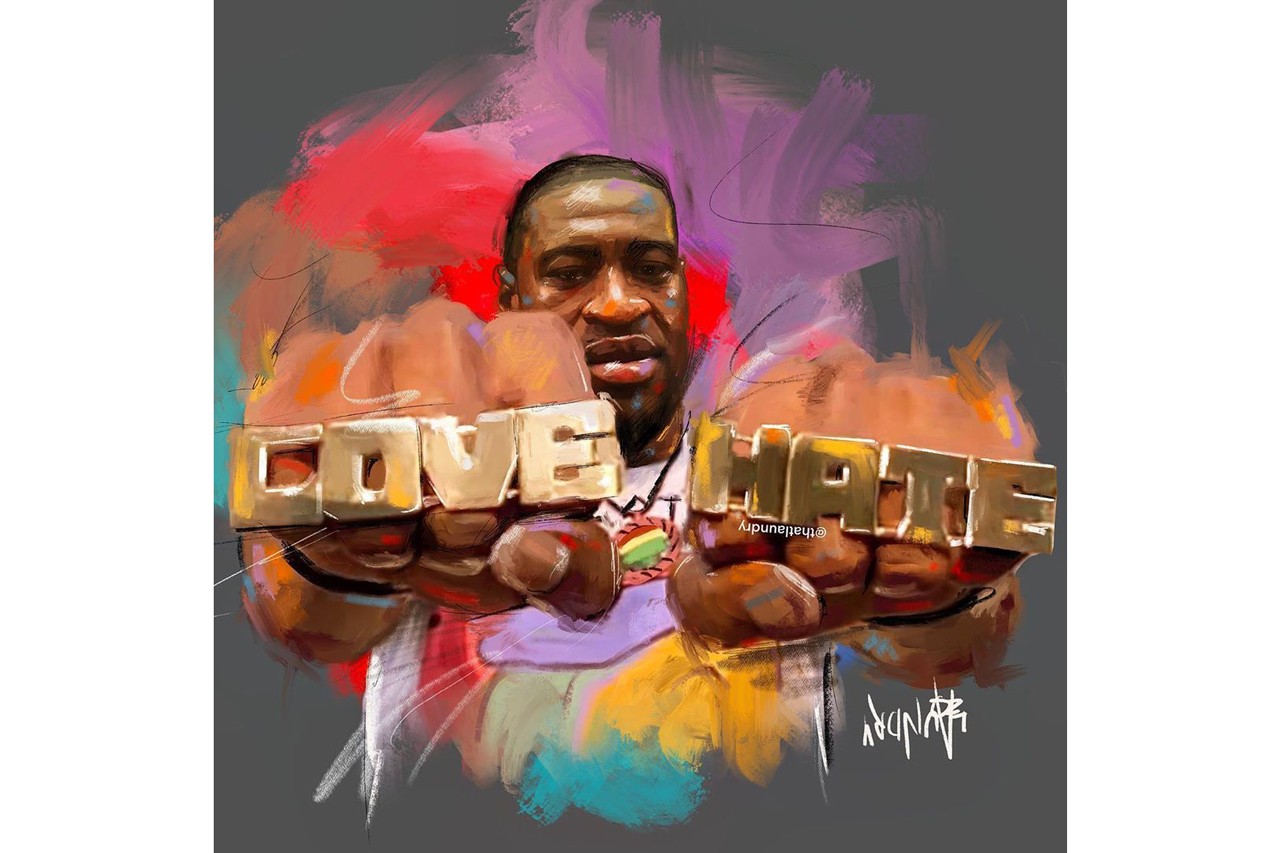
Phresh Laundry
What do you want to achieve with this work?
With this piece of art, I wish to shed light on the reality of police brutality against African Americans. The death of the character Radio Raheem in the movie “Do The Right Thing” at the hands of police, one would hope this would have remained a fictional story. However, the truth is that it is a reality more than many people acknowledge. As a Black man in America, I have seen instances where my race is continuously asked to remain silent, even when we are peaceful. Art is my craft, my gift from God, that no one can shut down.
What response have you received?
I have received positive responses. My work received world-wide attention. It was even shared on Instagram by Spike Lee himself.
How do you see the art world/industry responding to the protests?
It’s been a joy to see other artists capture the call for social change, even though they are creating out of an unfortunate situation. The ability for an artist to be able to share their craft and paint is a blessing. I’m excited to see what will take place in the art culture in days, months, and years ahead. Art is an important social just tool because sometimes, reading a newspaper article, seeing a social media post, or hearing voices speak on a social issue, doesn’t quite connect with a person’s mind and heart. Visual representations can allow people to relate to something in a different way.

Ashley R. Smith
What do you want to achieve with this work?
The initial goal of creating this piece was for me to garner some kind of peace for myself. I woke up that morning on the edge of a panic attack, and I just felt like I needed to honor George Floyd in some kind of way. Once I created it, I knew I did the right thing and truly I felt a lot of peace in the process.
How do you see the art world/industry responding to the protests?
From my perspective, I see many artists who may have been hesitant about using their gift as a form of protest finally making a statement with their work. As someone who was always afraid to use my art in this way, I finally felt empowered to do so this week. I believe this is a trend that will continue in the art world.
Why is sharing this work on social media so valuable?
Earlier I mentioned that I created the painting of George Floyd as a way to honor him and bring some peace to myself that day. I felt this was something we all needed and not just me. As much as I hesitate to share my work, sharing the painting process on my YouTube and Instagram just felt like the right thing to do for anyone who was also struggling to find a way to get a hold of their emotional state.

Láolú Senbanjo
What do you want to achieve with this work?
The frustration among Black Americans with this country’s unwillingness to exist with integrity has been evolving for centuries. It has become exhausting and overwhelming, and every time there is a new senseless death, or blatant manifestation of harmful white supremacy it is another experience of trauma for which there is not enough recognition, healing, and corrective action. I want my art to help all of us to instigate, remember, imagine, discuss, and express these complex experiences and feeling states. So much is and remains unspoken. This is difficult work, and art is necessary at every stage. Cultural work is vital to our evolution as a society.
What response have you received?
I have received a broad range of positive responses for this piece from the media and art enthusiasts in general; CNN recently featured it as well. It gives me solace to know that people feel the emotion in the art and see the pain. It was a very emotional piece for me to create and I’m glad that others share in that.
How do you see the art world/industry responding to the protests?
I think that the art world is rightly enthused and supportive of pieces that are inspired by the protests. While this is surely a good thing, I worry that it runs the risk of typecasting artists that create such work. The reason is that you don’t find as much representation of such artists (who are usually Black) during “normal” times. Thus, I would like the appreciation and representation of Black artists to continue beyond creations.
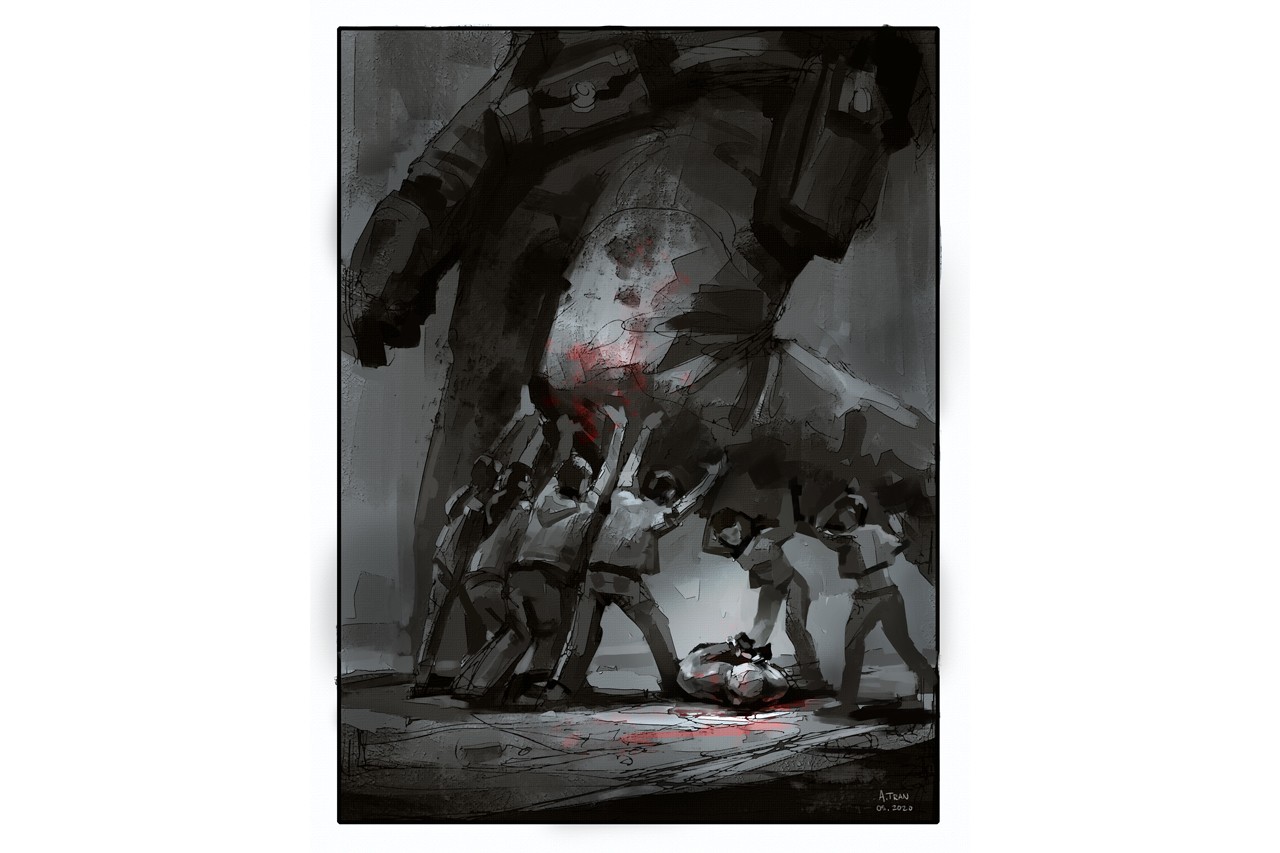
Andrew Dat Tran
What do you want to achieve with this work?
Like so many others around the world, I was disgusted, shocked, and angry when I watched the footage of Floyd’s murder. I felt like I had to do something. As an artist, the loudest voice I have is spoken through my artwork. I wanted to convey all the emotions that we all felt into the piece that we can’t express simply through words.
How do you see the art world/industry responding to the protests?
Art can inspire hope and peace sometimes more powerfully than words can. I hope I can inspire others, especially artists, to spread their message of compassion, empathy, and love through the creation of meaningful artwork. I’ve been seeing more and more artists creating art based on this and it’s inspiring for me to see.
Why is sharing this work on social media so valuable?
Sharing the art on social media allows people to use it as a platform so that they can be heard. It can draw eyes toward their cause and allow them to amplify their message. Especially online on platforms like Instagram where pictures can speak louder than words.
What do you want to achieve with this work?
Initially, I didn’t know how to respond to the racism going on in America and George Floyd’s murder was the catalyst that made me realize that I had to use my voice. And the only way I knew how to speak was visually. For me, the actual work is in the time-lapse. I used the audio from the video of Floyd being pinned down by the police and hearing his last words. I played the time-lapse in reverse where Floyd starts off by saying “I can’t breathe.” As I’m unpainting his face, you can simultaneously hear the life being squeezed out of him as if he is disappearing before your eyes. Before painting Floyd, I’d only seen snippets of the video but after watching it in its entirety and hearing his pain, I just couldn’t stop balling my eyes out. I wanted to use my art as a vehicle for others to hear the suffering in Floyd’s voice and to really feel something.
What response have you received?
I’ve had an overwhelming response of people feeling the same way I did which makes me feel like it was successful in opening peoples eyes, ears and hearts to realizing that WE DO have a problem and RACISM HAS TO STOP.
How do you see the art world/industry responding to the protests?
Honestly, I feel like the art world isn’t doing enough responding to the protests. I’ve only seen a few artists really get involved so there’s so much more that artists can contribute visually. After participating in the protests today in NYC, I was so inspired by what I’d seen that I want to create more.
I also wanted to add, I had no intention of selling or making money off this piece. My friend Evan Turner (@evanturner) who plays for the Minnesota Timberwolves reached out to buy the piece and when I told him it wasn’t for sale, he said he wanted to buy it so he could give it to Floyd’s “twin” Stephen Jackson (@_stak5_) who is a former NBA player. I still wouldn’t sell it but I knew Stephen would be the rightful owner so Evan and I are giving the piece to him.
What do you want to achieve with this work?
All of my work is about making a question to the public and making people think and react so I wanted to put the attention on what was happening in the United States which is a common problem in Europe also because a lot of times the police have arrested black people and I wanted to reflect that in my work. Things have to change.
How do you see the art world/industry responding to the protests?
I had a feeling that it was going to become something big because of the first reaction and the reaction of President Trump. It was a big issue and I wanted to shed light on that.
Why is sharing this work on social media so valuable?
A lot of the works of mine are critical so they have short lives. A lot of the authorities remove them so it’s important to record everything and have it also online so they can have a longer life.

David Park
What do you want to achieve with this work?
This is based on a photo my friend Laura Fuchs (@laurasfuchs) took. She has been taking amazing photos during the pandemic and protests. Looking at her photos I could feel the frustration, anger, and pain of the people and I wanted to express that in my own ways.
What responses have you received?
The responses have mostly been positive. I love connecting current events with iconic items/people/moments from the past so that my viewers who share my interests and have lived through those moments can relate easily. I get really excited when people recognize the cultural references and respond to it.
It’s also frustrating how the issue of racial injustice hasn’t been fixed for so long that I could dig up things I drew years or even a decade ago and repurpose them today and they would still be relevant.
How do you see the art world/industry responding to the protests?
I personally would like it if the art world could assist the protestors (like how Shepard Fairey’s work was used for Obama). When conveying messages, art can help make it easier and more relatable.
Since I believe many artists stand together in this issue, I would also love to see group shows surrounding this topic so many different artists can bring different perspectives and more awareness.


